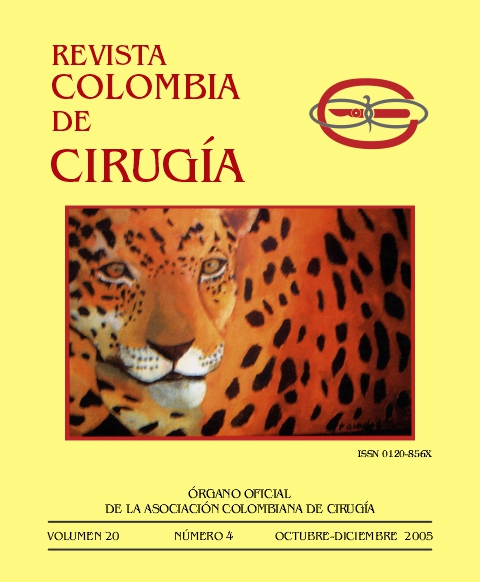Interpretación clínica de los experimentos clínicos en cáncer
Palabras clave:
ensayos clínicos controlados, investigación clínica, epidemiologíaResumen
La evaluación del beneficio de una terapia es crucial para decidir si un nuevo tratamiento debe ser usado. Los clínicos que utilizan los resultados de los experimentos clínicos para guiar su práctica médica necesitan herramientas útiles para evaluar la importancia clínica de los resultados estadísticamente significativos antes de introducir una nueva terapia en cáncer en la práctica clínica.
El objetivo de esta revisión es proponer a los intervalos de confianza como los instrumentos útiles para juzgar la importancia clínica de un tratamiento, dado que éstas hacen explícita la evaluación del beneficio de una terapia y permiten atenuar el énfasis de la interpretación de los experimentos clínicos sólo con base en el criterio estadístico.
Descargas
Referencias bibliográficas
2. MOHER D, DULBERG CS, WELLS GA. Statistical power, sample size, and their reporting in randomized controlled trials. JAMA 1994; 272: 122-124.
3. CHAN KBY, MAN-SON-HING M, MOLNAR FJ, et al. How well is the clinical importance of study results reported? An Assessment of Randomized Controlled Trials. CMAJ 2001; 165: 1197-1202.
4. RESTREPO MM, GÓMEZ C. Sesgos en diseños analíticos. Rev Col Psiqui 2004; 33: 327-335.
5. GUYATT GH, SACKETT DL, COOK DJ. Users’ guides to the medical literature. ii. how to use an article about therapy or prevention. A. Are the results of the study valid? evidence-based medicine working group. JAMA 1993; 270: 2598-2601.
6. ROTHMAN KJ, GREENLAND S. “Approaches To Statistical Analysis”. En: Rothman KJ, Greenland S. Modern Epidemiology. LippincottRaven, 1998; 183-199.
7. STERNE JAC, SMITH GD, COX DR. Sifting The evidence{—}What’s Wrong with significance tests? another comment on the role of statistical methods. BMJ 2001; 322: 226-231.
8. BROWNER WS, NEWMAN TB. Are all significant p values created equal? the analogy between diagnostic tests and clinical research. JAMA 1987; 257: 2459-2463.
9. CASTAÑEDA JA, GIL JF. Una mirada a los intervalos de confianza en investigación. Rev Col Psiqui 2004; 33: 193-201.
10. JAESCHKE R, SINGER J, GUYATT GH. Measurement of health status. ascertaining the minimal clinically important difference. Control Clin Trials 1989; 10: 407-415.
11. BARRATT A, WYER PC, HATALA R, et al. Tips for learners of evidencebased medicine: 1. Relative risk reduction, absolute risk reduction and number needed to treat. CMAJ 2004; 171: 353-358.
12. COOMBES RC, HALL E, GIBSON LJ, et al. A randomized trial of exemestane after two to three years of tamoxifen therapy in postmenopausal women with primary breast cancer. N Engl J Med 2004; 350: 1081-1092.
13. GOSS PE, INGLE JN, MARTINO S, et al. A randomized trial of letrozole in postmenopausal women after five years of tamoxifen therapy for early-stage breast cancer. N Engl J Med 2003; 349: 1793-1802.
14. BAUM M, BUDZAR AU, CUZICK J, et al. Anastrozole alone or in combination with tamoxifen versus tamoxifen alone for adjuvant treatment of postmenopausal women with early breast cancer: first results of the ATAC randomized trial. Lancet 2002; 359: 2131-2139.
15. BAUM M, BUZDAR A, CUZICK J, et al. Anastrozole alone or in combination with tamoxifen versus tamoxifen alone for adjuvant treatment of postmenopausal women with early-stage breast cancer: results of the ATAC (Arimidex, Tamoxifen Alone or in Combination) trial efficacy and safety update analyses. Cancer 2003; 98: 1802-1810.
16. WHITLEY E, BALL J. Statistics review 3: hypothesis testing and p values. Crit Care 2002; 6: 222-225.
17. LEUNG WC. Balancing statistical and clinical significance in evaluating treatment effects. Postgrad Med J 2001; 77: 201-204.
18. BURTON PR, GURRIN LC, CAMPBELL MJ. Clinical significance not statistical significance: a simple bayesian alternative to p values. J Epidemiol Community Health 1998; 52: 318-323.
19. SERRANO M. La medicina basada en la evidencia: un nuevo paradigma en la interpretación de la información médica. Rev Colomb Cir 1999; 14: 134-139.
20. GUYATT GH, SACKETT DL, COOK DJ. Users’ guides to the medical literature. II. How to use an article about therapy or prevention. b. what were the results and will they help me in caring for my patients? Evidence-Based Medicine Working Group. Jama 1994; 271: 59-63.
Descargas
Publicado
Cómo citar
Número
Sección
Licencia
Todos los textos incluidos en la Revista Colombiana de Cirugía están protegidos por derechos de autor. Las opiniones expresadas en los artículos firmados son las de los autores y no coinciden necesariamente con las de los directores o los editores de la Revista Colombiana de Cirugía. Las sugerencias diagnósticas o terapéuticas como elección de productos, dosificación y métodos de empleo corresponden a la experiencia y al criterio de los autores.


















.jpg)


